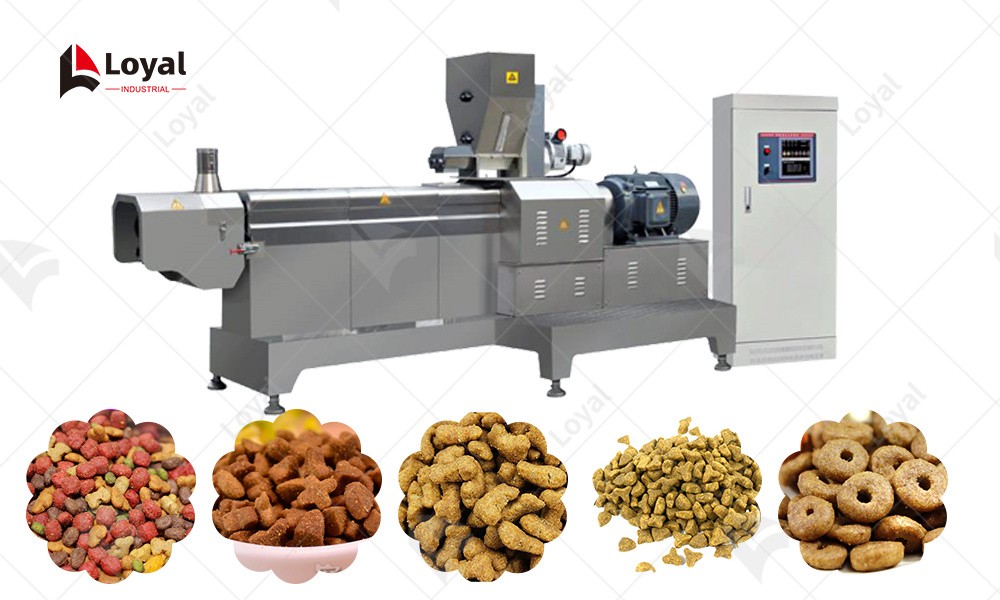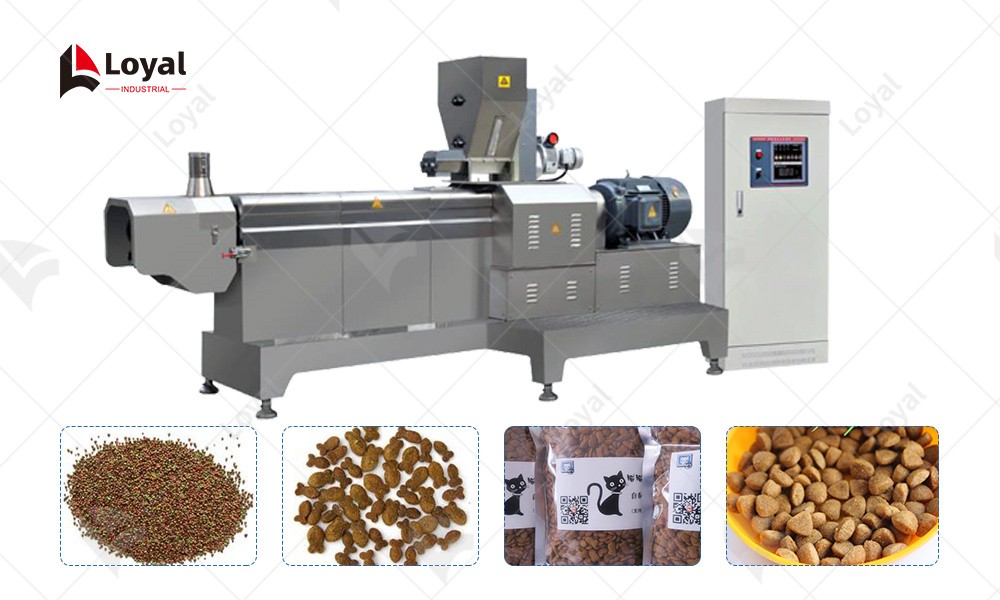
- Shandong Loyal Industrial Co.,Ltd.
- Macaroni Production Machine Instant Noodle Machine Biscuit Making Machine
Home> Company News> The Ultimate Guide To Dog Food Pellet Processing Line Updated 2024

The Ultimate Guide To Dog Food Pellet Processing Line Updated 2024
2024-10-16 16:24:27Overview of the Dog Food Industry and the Importance of Automation
The dog food industry has seen significant growth in recent years, driven by increasing pet ownership and evolving consumer preferences. As a result, the demand for high-quality, nutritious, and convenient dog food options has never been higher. To meet this demand, manufacturers are constantly seeking ways to improve efficiency, reduce costs, and ensure product consistency. One key solution to these challenges lies in the advanced automation of dog food pellet processing lines.
Automation in the dog food industry, particularly in the production of pellets, offers numerous benefits. Dog food pellet process lines can be automated to handle the entire production process from raw material mixing and formulation to extrusion, shaping, packaging, and labeling. This not only streamlines operations but also ensures consistent product quality and reduces the risk of human error.
According to industry experts, automation is becoming increasingly critical as the dog food market continues to expand. "As consumers demand more variety and higher quality in their pet food options, manufacturers must find ways to innovate and streamline their production processes," says Dr. Jane Smith, a leading expert in pet food technology. "Advanced automation is a key driver of this innovation, enabling manufacturers to meet these demands while maintaining profitability."
In the next section, we will delve into the key components of advanced automation in dog food pellet processing lines, exploring how these technologies are shaping the future of the industry.

Key Components of Advanced Automation in Dog Food Pellet Processing
Advanced automation in dog food pellet processing lines is composed of several key components that work together to streamline production, enhance product quality, and reduce costs. Here are some of the most critical elements:
Automated Mixing and Formulation Systems: These systems are designed to accurately measure and mix raw materials, such as grains, proteins, and vitamins, to create a consistent formula. By automating this process, manufacturers can ensure that each batch of dog food pellets contains the precise proportions of ingredients needed to meet nutritional standards.
Conveyor Belts and Feeding Mechanisms: Conveyor belts and automated feeding mechanisms transport raw materials and finished products throughout the production line. These systems reduce the need for manual handling, which can improve safety and reduce the risk of contamination. Additionally, they enable manufacturers to maintain a steady flow of materials, ensuring that production runs smoothly and efficiently.
Extrusion and Shaping Technology: Extrusion is a critical step in the production of dog food pellets. Automated extrusion machines apply pressure and heat to the mixed raw materials, forcing them through a die to create the desired shape and size of pellets. Advanced extrusion technology can also be used to add textures and flavors to the pellets, enhancing their appeal to dogs.
Automated Packaging and Labeling Systems: Once the pellets are produced, they must be packaged and labeled for distribution. Automated packaging machines can quickly and accurately fill bags or containers with the correct amount of pellets, while labeling systems ensure that each package is correctly identified with the necessary information, such as the product name, ingredients, and expiration date.
In the next section, we will explore the challenges and solutions associated with implementing advanced automation in dog food pellet processing lines.

Challenges and Solutions in Implementing Advanced Automation
While the benefits of advanced automation in dog food pellet processing lines are clear, there are also several challenges that manufacturers must address to successfully implement these technologies. Here are some of the most common challenges and potential solutions:
High Initial Investment Costs: Advanced automation systems can be expensive to purchase and install. Manufacturers may struggle to justify the investment, particularly if they are already operating efficiently or have limited capital. However, the long-term benefits of automation, such as increased productivity, reduced labor costs, and improved product quality, can often outweigh the initial costs.
Integration with Existing Systems: Integrating new automation systems with existing equipment and processes can be challenging. Manufacturers must ensure that the new systems are compatible with their current operations and that they can be seamlessly integrated into the production line. This may require custom solutions or modifications to existing equipment.
Training and Skill Development: Automated systems require a highly skilled workforce to operate and maintain. Manufacturers must invest in training programs to ensure that their employees have the necessary skills and knowledge to work with the new technology. This can include on-site training, online courses, and partnerships with educational institutions.
Data Management and Analysis: Advanced automation systems generate a large amount of data, which must be managed and analyzed to maximize the benefits of automation. Manufacturers must implement robust data management systems to collect, store, and analyze this data. This can help them identify areas for improvement, optimize production processes, and make better-informed decisions.
Despite these challenges, many manufacturers are finding ways to overcome them and successfully implement advanced automation in their dog food pellet processing lines. In the next section, we will discuss the benefits and improvements that have been observed after automation.

Benefits and Improvements Observed After Automation
After implementing advanced automation in dog food pellet processing lines, manufacturers have reported several benefits and improvements. Here are some of the most notable:
Increased Productivity and Efficiency: Automation systems can significantly increase productivity and efficiency by reducing downtime, minimizing waste, and optimizing production processes. This enables manufacturers to produce more dog food pellets in a shorter amount of time, while maintaining high product quality.
Improved Product Quality: Automated systems can help manufacturers maintain consistent product quality by accurately measuring and mixing raw materials, and by monitoring and controlling production processes. This reduces the risk of contamination and ensures that each batch of dog food pellets meets nutritional standards.
Reduced Labor Costs: Automation can reduce the need for manual labor, which can lower labor costs and improve safety. By automating repetitive and dangerous tasks, manufacturers can protect their employees from injuries and reduce the risk of human error.
Scalability and Flexibility: Automated systems can be scaled up or down to meet changing production demands. This enables manufacturers to quickly adapt to market changes, such as increased demand or new product launches. Additionally, automation systems can be configured to produce a variety of dog food pellet sizes, shapes, and textures, providing manufacturers with greater flexibility in their product offerings.
Data-Driven Decision Making: By collecting and analyzing data from automated systems, manufacturers can gain insights into their production processes and make data-driven decisions to improve efficiency, reduce waste, and optimize production. This can lead to cost savings and improved competitiveness in the market.
In conclusion, advanced automation in dog food pellet processing lines offers numerous benefits, including increased productivity, improved product quality, reduced labor costs, scalability, and data-driven decision making. While there are challenges associated with implementing automation, many manufacturers are finding ways to overcome them and successfully integrate these technologies into their operations.

Future Trends and Innovations in Dog Food Pellet Processing Automation
As technology continues to evolve, we can expect to see new trends and innovations in dog food pellet processing automation. Here are some of the most promising developments on the horizon:
Artificial Intelligence and Machine Learning: AI and machine learning algorithms can be used to optimize production processes, predict maintenance needs, and identify areas for improvement in real-time. By analyzing data from automated systems, AI can help manufacturers make more informed decisions and improve overall efficiency.
Internet of Things (IoT) Integration: IoT technology enables devices and systems to communicate with each other over the internet. In dog food pellet processing, IoT can be used to monitor and control production processes remotely, collect data in real-time, and streamline supply chain management. This can lead to improved productivity, reduced waste, and better inventory management.
Robotics and Collaborative Automation: Robotics and collaborative automation systems can perform tasks that are too dangerous, repetitive, or precise for humans to handle. These systems can work alongside humans to improve safety, reduce labor costs, and increase productivity. As robotics technology continues to advance, we can expect to see more sophisticated and versatile robots being used in dog food pellet processing.
Sustainable Manufacturing Practices: Manufacturers are increasingly focused on reducing their environmental impact and adopting sustainable manufacturing practices. Automation can play a key role in this by optimizing production processes to reduce waste, energy consumption, and emissions. Additionally, automated systems can be used to recycle and repurpose materials, further reducing the environmental footprint of dog food pellet production.
Personalized Nutrition and Customization: As consumers become more aware of the importance of personalized nutrition for their pets, manufacturers are looking for ways to offer customized dog food pellet options. Automation can help manufacturers produce a wider range of products with different nutritional profiles, sizes, shapes, and textures to meet the diverse needs of pet owners.
In conclusion, the future of dog food pellet processing automation is bright, with exciting new trends and innovations on the horizon. By staying up-to-date with the latest technology and continuously seeking ways to improve efficiency, quality, and sustainability, manufacturers can stay ahead of the competition and meet the evolving needs of pet owners.
Reference
The following are five authoritative foreign literature websites in the field of Industrial food machinery:
1. Food Engineering Magazine
Website: https://www.foodengineeringmag.com/
2.Food Processing Magazine
Website: https://www.foodprocessing.com/
3.Journal of Food Engineering
Website:https://www.journals.elsevier.com/journal-of-food-engineering
4. Food Manufacturing Magazine
Website:https://www.foodmanufacturing.com/
5. International Journal of Food Science & Technology
Website:https://onlinelibrary.wiley.com/
 Commercial Japanese Panko Bread Crumb Grinder Machine
Commercial Japanese Panko Bread Crumb Grinder Machine Japanese Bread Crumbs Processing Line
Japanese Bread Crumbs Processing Line Automatic Cookies Making Machines
Automatic Cookies Making Machines Fully Automatic Biscuit Making Machines
Fully Automatic Biscuit Making Machines